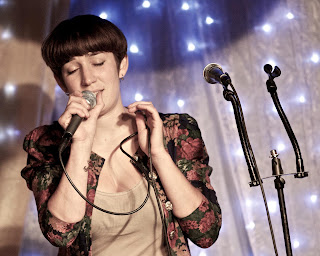By Taylor Jones
While the stars glimmer in the air tonight, they shine inside the Alternative Café, freshly painted on the deep purple walls of their current art exhibit The Socio-Network. This collection is a display of works from artists around the world, gathered through the means of social networking sites and blogs. I walk past the Christmas tree in the show room to find my seat and casually study a piece by Eugene Plotnikov titled “Alone on the Moon.” The work depicts a disembodied junk figure who is pushing a baby robot in a shopping cart across the moon, looking with remorse toward another moon in the distance. However, not quite as far away as the moon is tonight’s main attraction, the smooth and Latin jazz of the four-piece called Aporia.
My attention is suddenly drawn to the stage when a familiar face, bass player Heath Proskin of the Something Cool Trio (who I saw perform last month), begins playing his upright bass with a bow. Once Proskin tunes and prepares his instrument, vocalist Julie Capili, drummer Jen Schaff (also in Something Cool), and saxophonist/clarinetist Stu Reynolds join him and begin to play “In a Sentimental Mood” by Duke Ellington. Proskin closes his eyes and travels to his musical zone where he begins to pluck a Latin take of Ellington’s song before transitioning into the calm, original interpretation. In this laid back mood, Reynolds shares his clarinet’s warm tones with the audience.
Next, the group performs Nina Simone’s “Feeling Good,” in which Reynolds switches to his saxophone and starts to harmonize with Capili, not quiet synching up or blending like it should. Nevertheless, the song really kicks into gear when Schaaf and Proskin lay down a stinky beat that would make Mark Wahlberg’s Funky Bunch weep in shame. When I saw this rhythm section play with Bill Minor in the Something Cool Trio they were still very tight, but relaxed and restrained. Tonight they really come alive playing with Aporia, shown as Schaaf channels a keen sense of intensity in her brush playing and dynamically expresses herself.
Another form of expression can be observed on the wall about five rows behind me in Max Capacity’s Andy Warhol type pop art. One of my favorite pieces in the exhibit is Capacity’s bright pink Godzilla, instilling fear in the hearts of doomed citizens with its bright orange teeth and piercing green eyes.
When Aporia breaks into Reynolds’ original song “Samba for Two,” Schaaf makes friends with a pair of maracas and progresses the song by integrating a samba pattern on the snare. Her kick drum sits on the downbeats while the hi-hat clicks on every up beat, giving the song an assertive sense of motion. Then the beat breaks down for a drum feature between Schaaf and Reynolds, who picks up a small, metal drum and rubs it to make a squeaky sound, uncomfortably resembling the cleaning of a window. Alas, the drums naturally fade out and leave Reynolds playing a solo on his bass clarinet, producing a wealth of low tones that carry throughout the café. Inconspicuously, the drums and bass start to merge back into the song as they end with a grand a tempo reprise. Overall, this original arrangement by Reynolds proved very interesting in that it took the audience on an adventure through many different moods.
Being a jazz musician myself, I know Reynolds tells the truth when he says to the audience “improvisation is at our hearts,” for they really show it in this next exercise. Reynolds says they are going to create a song on the spot and asks for the help of the crowd in constructing the tune. Rhythm is the basis for music, so he asks someone to clap a rhythm, “any rhythm.” Feeling like this is my time to shine as a drummer, I clap a traditional bossa nova pattern, and instantly Schaaf and Proskin start jamming. Next, Reynolds needs a key signature, so someone shouts “G Minor” and he begins to riff away. Not only do they make a melody on the spot, but Capili attempts to improvise some lyrics too, and it’s hard to make lyrics when someone shouts the topic “modern fashion.”
The group ends with the Thelonious Monk jazz standard “’Round Midnight,” beginning with a traditional interpretation and evolving to a unique Aporia spin of funky grooves. They play through their hip version and fall back into the “swing” of things, ending with a decrescendo that leaves a lone Proskin playing his bass, sounding like a badass funky sailor.
Aporia: defined as “A philosophical puzzle or a seemingly insoluble impasse in an inquiry,” performed in such a way tonight that will indeed leave us all with one question: “when can I see them again?”
Links:
 |
| Stu Reynolds |
 |
| Heath Proskin and Julie Capili |
 |
| (Left to right) Jenn Schaaf, Proskin, and Capili |
 |
| Reynolds, Schaaf, and Capili |
 |
| "Alone on the Moon" by Eugen Plotnikov |
 |
| "Godzilla" by Max Capacity |






















